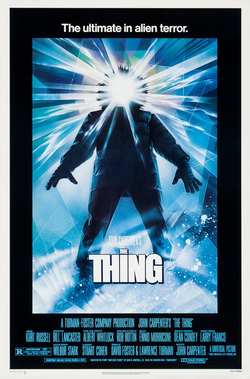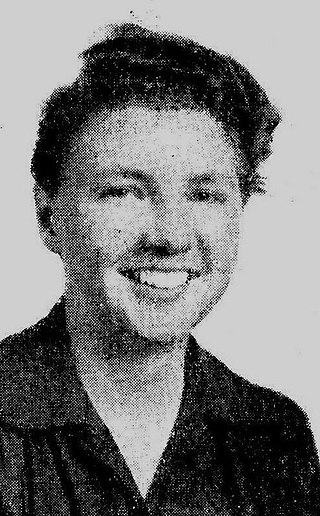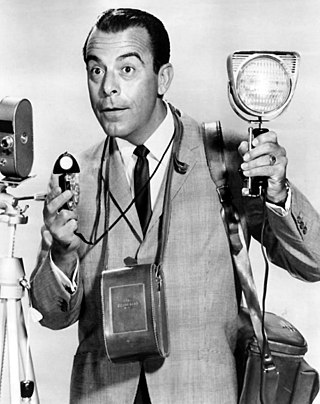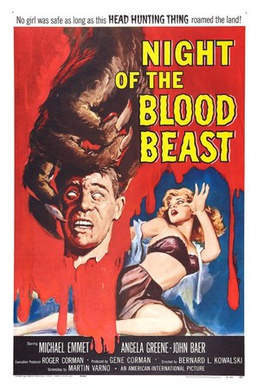
The Thing is a 1982 American science fiction horror film directed by John Carpenter from a screenplay by Bill Lancaster. Based on the 1938 John W. Campbell Jr. novella Who Goes There?, it tells the story of a group of American researchers in Antarctica who encounter the eponymous "Thing", an extraterrestrial life-form that assimilates, then imitates, other organisms. The group is overcome by paranoia and conflict as they learn that they can no longer trust each other and that any of them could be the Thing. The film stars Kurt Russell as the team's helicopter pilot R.J. MacReady, with A. Wilford Brimley, T. K. Carter, David Clennon, Keith David, Richard Dysart, Charles Hallahan, Peter Maloney, Richard Masur, Donald Moffat, Joel Polis, and Thomas G. Waites in supporting roles.

Leigh Douglass Brackett was an American science fiction writer known as "the Queen of Space Opera." She was also a screenwriter, known for The Big Sleep (1946), Rio Bravo (1959), and The Long Goodbye (1973). She worked on an early draft of The Empire Strikes Back (1980), elements of which remained in the film; she died before it went into production. In 1956, her book The Long Tomorrow made her the first woman ever shortlisted for the Hugo Award for Best Novel, and, along with C. L. Moore, one of the first two women ever nominated for a Hugo Award. In 2020, she posthumously won a Retro Hugo for her novel The Nemesis From Terra, originally published as "Shadow Over Mars".

Science fiction is a film genre that uses speculative, fictional science-based depictions of phenomena that are not fully accepted by mainstream science, such as extraterrestrial lifeforms, spacecraft, robots, cyborgs, mutants, interstellar travel, time travel, or other technologies. Science fiction films have often been used to focus on political or social issues, and to explore philosophical issues like the human condition.
Who Goes There? is a 1938 science fiction horror novella by American author John W. Campbell, written under the pen name Don A. Stuart. Its story follows a group of people trapped in a scientific outpost in Antarctica infested by shapeshifting monsters able to absorb and perfectly imitate any living being, including humans. Who Goes There? was first published in the August 1938 issue of Astounding Science Fiction magazine and was also printed as The Thing from Another World, as well as included in the collection by the same title. Its extended, novel version, found in an early manuscript titled Frozen Hell, was finally published in 2019.
Hiram Gilmore "Harry" Bates III was an American science fiction editor and writer. His short story "Farewell to the Master" (1940) was the basis of the science fiction movie The Day the Earth Stood Still (1951).

George Watt Fenneman was an American radio and television announcer. Fenneman is best remembered as the show announcer and straight man on Groucho Marx's You Bet Your Life. Marx, said of Fenneman in 1976, "There never was a comedian who was any good unless he had a good straight man, and George was straight on all four sides". Fenneman, born in Peking (Beijing), China, died from respiratory failure in Los Angeles, California, on May 29, 1997, at the age of 77.

Jesse Kenneth Tobey was an American actor active from the early 1940s into the 1990s, with over 200 credits in film, theatre, and television. He is best known for his role as a captain who takes charge of an Arctic military base when it is attacked by a plant-based alien in The Thing from Another World (1951), and a starring role in the 1957-1960 Desilu Productions TV series Whirlybirds.

Robert Rae Cornthwaite was an American film and television character actor.

Children of the Damned is a 1964 British black-and-white science fiction horror film, a thematic sequel to 1960s Village of the Damned, which concerns a group of children with similar psi-powers to those in the earlier film. The film enables an interpretation of the children as being a good and more pure form of human being, rather than evil and alien.
"Ice" is the eighth episode of the first season of the American science fiction television series The X-Files, premiering on the Fox network on November 5, 1993. It was directed by David Nutter and written by Glen Morgan and James Wong. The debut broadcast of "Ice" was watched by 10 million viewers in 6.2 million households. The episode received positive reviews at large from critics, who praised its tense atmosphere.

The Naked Monster is a 2005 American ultra low-budget science-fiction and horror comedy fan film written by Ted Newsom and directed by Newsom and Wayne Berwick as an homage to and spoof of the "giant monster-on-the-loose" films of the 1950s. The final project took 21 years to make, and was the final film for Kenneth Tobey, John Agar, Lori Nelson and Robert Clarke.
Christian Nyby was an American television and film director and editor. As an editor, he had seventeen feature film credits from 1943 to 1952, including The Big Sleep (1946) and Red River (1948). From 1953 to 1975 he was a prolific director of episodes in many television series, including Gunsmoke and Wagon Train. As a feature film director, he is likely best known for The Thing from Another World (1951).

The Atomic Submarine is a 1959 independently made, American black-and-white science-fiction film directed by Spencer Gordon Bennet and starring Arthur Franz, Dick Foran, Brett Halsey, Joi Lansing and Jean Moorhead, with John Hilliard as the voice of the alien. The film was produced by Alex Gordon and distributed by Allied Artists Pictures Corporation.

The Man from Planet X is a 1951 independently made American black-and-white science fiction horror film, produced by Jack Pollexfen and Aubrey Wisberg, directed by Edgar G. Ulmer, that stars Robert Clarke, Margaret Field, and William Schallert. The film was distributed by United Artists.

Night of the Blood Beast is a 1958 American science-fiction horror film about a team of scientists who are stalked by an alien creature, which implants its embryos in an astronaut's body during a space flight. Produced by exploitation filmmaker Roger Corman and his brother Gene, it was one of the first films directed by Bernard L. Kowalski and was written by first-time screenwriter Martin Varno, who was 21 years old. It starred several actors who had regularly worked with Roger Corman, including Michael Emmet, Ed Nelson, Steve Dunlap, Georgianna Carter and Tyler McVey. The film was theatrically released in December 1958 as a double feature with She Gods of Shark Reef.

Tarzan and the Slave Girl is a 1950 American adventure film directed by Lee Sholem and starring Lex Barker as Tarzan, Vanessa Brown as Jane, and Robert Alda as big game hunter Neil. The fourteenth film of the Tarzan film series that began with 1932's Tarzan the Ape Man, the plot involves a lost civilization in Africa, a strange illness, and an evil counselor manipulating a prince into kidnapping large numbers of local women.
Howard Hawks (1896–1977) was an American film director who made 40 films between 1926 and 1970. He is responsible for classic films in genres ranging from film noir, screwball comedy, crime, science fiction and Western.

The Thing is a 2011 American science fiction horror film directed by Matthijs van Heijningen Jr., written by Eric Heisserer, and starring Mary Elizabeth Winstead, Joel Edgerton, Ulrich Thomsen, Adewale Akinnuoye-Agbaje, and Eric Christian Olsen. It is a direct prequel to the 1982 film of the same title by John Carpenter, which was an adaptation of the 1938 novella Who Goes There? by John W. Campbell. It tells the story of a team of scientists on a Norwegian Antarctic research station who discover a parasitic alien buried deep in the ice, realizing too late that it is still alive.

Creature with the Atom Brain is a 1955 American zombie horror science fiction film directed by Edward L. Cahn and starring Richard Denning.

The Thing is a fictional shapeshifting and telepathic alien from The Thing science fiction horror franchise. It first appeared in the novella Who Goes There? by John W. Campbell, which has been adapted into various media, including films, literature, and video games.
















